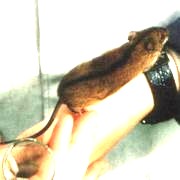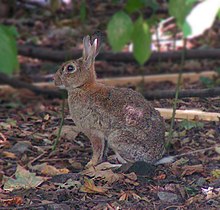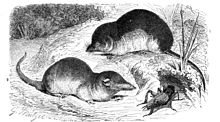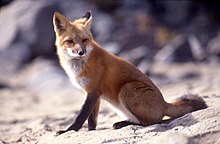List of mammals of Greece
This list shows the IUCN Red List status of the 115 mammal species occurring in Greece. Two of them are endangered, twelve are vulnerable, and six are near threatened. The following tags are used to highlight each species' status as assessed on the respective IUCN Red List published by the International Union for Conservation of Nature:
| EX | Extinct | No reasonable doubt that the last individual has died. |
| EW | Extinct in the wild | Known only to survive in captivity or as a naturalized populations well outside its previous range. |
| CR | Critically endangered | The species is in imminent risk of extinction in the wild. |
| EN | Endangered | The species is facing an extremely high risk of extinction in the wild. |
| VU | Vulnerable | The species is facing a high risk of extinction in the wild. |
| NT | Near threatened | The species does not meet any of the criteria that would categorise it as risking extinction but it is likely to do so in the future. |
| LC | Least concern | There are no current identifiable risks to the species. |
| DD | Data deficient | There is inadequate information to make an assessment of the risks to this species. |


Rodents make up the largest order of mammals, with over 40% of mammalian species. They have two incisors in the upper and lower jaw which grow continually and must be kept short by gnawing.
- Suborder: Sciurognathi
- Family: Sciuridae (squirrels)
- Subfamily: Sciurinae
- Tribe: Sciurini
- Genus: Sciurus
- Caucasian squirrel, S. anomalus LC
- Red squirrel, S. vulgaris LC[1]
- Genus: Sciurus
- Tribe: Sciurini
- Subfamily: Xerinae
- Tribe: Marmotini
- Genus: Spermophilus
- European ground squirrel, Spermophilus citellus EN
- Genus: Spermophilus
- Tribe: Marmotini
- Subfamily: Sciurinae
- Family: Gliridae (dormice)
- Subfamily: Leithiinae
- Genus: Dryomys
- Forest dormouse, Dryomys nitedula LC
- Genus: Muscardinus
- Hazel dormouse, Muscardinus avellanarius LC
- Genus: Myomimus
- Roach's mouse-tailed dormouse, Myomimus roachi VU
- Genus: Dryomys
- Subfamily: Glirinae
- Genus: Glis
- European edible dormouse, Glis glis LC
- Genus: Glis
- Subfamily: Leithiinae
- Family: Spalacidae
- Subfamily: Spalacinae
- Genus: Nannospalax
- Lesser blind mole-rat, Nannospalax leucodon LC
- Anatolian blind mole-rat, Nannospalax xanthodon LC
- Genus: Nannospalax
- Subfamily: Spalacinae
- Family: Cricetidae
- Subfamily: Cricetinae
- Genus: Cricetulus
- Grey dwarf hamster, Nothocricetulus migratorius LC
- Genus: Cricetulus
- Subfamily: Arvicolinae
- Genus: Arvicola
- European water vole, A. amphibius LC[2]
- Genus: Chionomys
- European snow vole, Chionomys nivalis LC
- Genus: Clethrionomys
- Bank vole, Clethrionomys glareolus LC
- Genus: Microtus
- Felten's vole, Microtus felteni LC
- Günther's vole, Microtus guentheri LC
- European pine vole, Microtus subterraneus LC
- East European vole, Microtus mystacinus LC
- Thomas's pine vole, Microtus thomasi LC
- Genus: Arvicola
- Subfamily: Cricetinae
- Family: Muridae (mice, rats, voles, gerbils, hamsters, etc.)
- Subfamily: Deomyinae
- Genus: Acomys
- Crete spiny mouse, Acomys minous VU
- Genus: Acomys
- Subfamily: Murinae
- Genus: Mus
- House mouse, Mus musculus LC[3]
- Macedonian mouse, Mus macedonicus LC
- Steppe mouse, Mus spicilegus LC
- Genus: Micromys
- Eurasian harvest mouse, Micromys minutus LC
- Genus: Apodemus
- Striped field mouse, Apodemus agrarius LC
- Yellow-necked mouse, Apodemus flavicollis LC
- Western broad-toothed field mouse, Apodemus epimelas LC
- Broad-toothed field mouse, Apodemus mystacinus LC
- Wood mouse, Apodemus sylvaticus LC
- Steppe field mouse, Apodemus witherbyi LC
- Genus: Rattus
- Genus: Mus
- Subfamily: Deomyinae
- Family: Sciuridae (squirrels)
Order: Lagomorpha (lagomorphs)
[edit]
The lagomorphs comprise two families, Leporidae (hares and rabbits), and Ochotonidae (pikas). Though they can resemble rodents, and were classified as a superfamily in that order until the early 20th century, they have since been considered a separate order. They differ from rodents in a number of physical characteristics, such as having four incisors in the upper jaw rather than two.
- Family: Leporidae
- Genus: Lepus
- European hare, L. europaeus LC[4]
- Genus: Oryctolagus
- European rabbit, O. cuniculus EN introduced[5]
- Genus: Lepus
Order: Erinaceomorpha (hedgehogs and gymnures)
[edit]The order Erinaceomorpha contains a single family, Erinaceidae, which comprise the hedgehogs and gymnures. The hedgehogs are easily recognised by their spines while gymnures look more like large rats.
- Family: Erinaceidae (hedgehogs)
- Subfamily: Erinaceinae
- Genus: Erinaceus
- Northern white-breasted hedgehog, E. roumanicus LC[6]
- Genus: Erinaceus
- Subfamily: Erinaceinae
Order: Soricomorpha (shrews, moles, and solenodons)
[edit]


The "shrew-forms" are insectivorous mammals. The shrews and solenodons closely resemble mice while the moles are stout-bodied burrowers.
- Family: Soricidae (shrews)
- Subfamily: Crocidurinae
- Genus: Crocidura
- Bicolored shrew, Crocidura leucodon LC
- Güldenstädt's shrew, Croditura gueldenstaedtii LC[7]
- Cretan shrew, Crocidura zimmermanni EN
- Genus: Suncus
- Etruscan shrew, Suncus etruscus LC
- Genus: Crocidura
- Subfamily: Soricinae
- Tribe: Nectogalini
- Genus: Neomys
- Southern water shrew, Neomys milleri
- Eurasian water shrew, Neomys fodiens
- Genus: Neomys
- Tribe: Soricini
- Genus: Sorex
- Common shrew, Sorex araneus
- Eurasian pygmy shrew, Sorex minutus
- Genus: Sorex
- Tribe: Nectogalini
- Subfamily: Crocidurinae
- Family: Talpidae (moles)
- Subfamily: Talpinae
- Tribe: Talpini
- Genus: Talpa
- Mediterranean mole, Talpa caeca
- European mole, Talpa europaea
- Stankovic's mole, Talpa stankovici
- Genus: Talpa
- Tribe: Talpini
- Subfamily: Talpinae
Order: Chiroptera (bats)
[edit]


The bats' most distinguishing feature is that their forelimbs are developed as wings, making them the only mammals capable of flight. Bat species account for about 20% of all mammals.
- Family: Pteropodidae (flying foxes, Old World fruit bats)
- Subfamily: Pteropodinae
- Genus: Rousettus
- Egyptian fruit bat, R. aegyptiacus LC[8]
- Genus: Rousettus
- Subfamily: Pteropodinae
- Family: Vespertilionidae
- Subfamily: Myotinae
- Genus: Myotis
- Alcathoe bat, M. alcathoe DD[9]
- Lesser mouse-eared bat, M. blythii LC[10]
- Bechstein's bat, M. bechsteinii NT[11]
- Brandt's bat, M. brandti LC[12]
- Daubenton's bat, M. daubentonii LC[13]
- Long-fingered bat, M. capaccinii VU[14]
- Geoffroy's bat, M. emarginatus LC[15]
- Greater mouse-eared bat, M. myotis LC[16]
- Whiskered bat, M. mystacinus LC[17]
- Natterer's bat, M. nattereri LC[18]
- Genus: Myotis
- Subfamily: Vespertilioninae
- Genus: Barbastella
- Western barbastelle, B. barbastellus NT[19]
- Genus: Eptesicus
- Anatolian serotine bat, E. anatolicus LC[20]
- Serotine bat, E. serotinus LC
- Genus: Hypsugo
- Savi's pipistrelle, H. savii LC[21]
- Genus: Nyctalus
- Greater noctule bat, N. lasiopterus VU[22]
- Lesser noctule, N. leisleri LC[23]
- Common noctule, N. noctula LC[24]
- Genus: Pipistrellus
- Nathusius' pipistrelle, P. nathusii LC[25]
- Common pipistrelle, P. pipistrellus LC
- Kuhl's pipistrelle, P. kuhlii LC[26]
- Soprano pipistrelle, P. pygmaeus LC[27]
- Hanak's pipistrelle, P. hanaki VU[28]
- Genus: Plecotus
- Alpine long-eared bat, P. macrobullaris LC[29]
- Brown long-eared bat, P. auritus LC[30]
- Grey long-eared bat, P. austriacus NT
- Mediterranean long-eared bat, P. kolombatovici LC[31]
- Genus: Vespertilio
- Parti-coloured bat, V. murinus LC
- Genus: Barbastella
- Subfamily: Miniopterinae
- Genus: Miniopterus
- Common bent-wing bat, M. schreibersii VU[32]
- Genus: Miniopterus
- Subfamily: Myotinae
- Family: Molossidae
- Genus: Tadarida
- European free-tailed bat, T. teniotis LC
- Genus: Tadarida
- Family: Nycteridae
- Genus: Nycteris
- Egyptian slit-faced bat, N. thebaica LC[33]
- Genus: Nycteris
- Family: Rhinolophidae
- Subfamily: Rhinolophinae
- Genus: Rhinolophus
- Blasius's horseshoe bat, R. blasii LC[34]
- Mediterranean horseshoe bat, R. euryale NT[35]
- Greater horseshoe bat, R. ferrumequinum LC[36]
- Lesser horseshoe bat, R. hipposideros LC[37]
- Mehely's horseshoe bat, R. mehelyi VU[38]
- Genus: Rhinolophus
- Subfamily: Rhinolophinae


The order Cetacea includes whales, dolphins and porpoises. They are the mammals most fully adapted to aquatic life with a spindle-shaped nearly hairless body, protected by a thick layer of blubber, and forelimbs and tail modified to provide propulsion underwater. Dolphins are national animal of Greece although cetacean biodiversity in the Mediterranean is not as diverse as in nations facing outer oceans, and the Aegean Sea Greece's coasts are one of the furthermost basin of the inland sea and even less species regularly inhabit comparing to western basin.[39][40]
- Suborder: Mysticeti
- Family: Balaenopteridae (rorquals)
- Genus: Balaenoptera
- Common minke whale, B. acutorostrata LC[41]
- Fin whale, Balaenoptera physalus VU
- Genus: Balaenoptera
- Family: Balaenopteridae (rorquals)
- Suborder: Odontoceti
- Family: Physeteridae (sperm whales)
- Genus: Physeter
- Sperm whale, Physeter macrocephalus VU
- Genus: Physeter
- Family: Ziphiidae (beaked whales)
- Genus: Ziphius
- Cuvier's beaked whale, Ziphius cavirostris LC
- Genus: Mesoplodon
- Sowerby's beaked whale, Mesoplodon bidens LC
- Genus: Ziphius
- Superfamily: Platanistoidea
- Family: Phocoenidae (porpoises)
- Genus: Phocoena
- Harbour porpoise, Phocoena phocoena VU
- Genus: Phocoena
- Family: Delphinidae (marine dolphins)
- Genus: Tursiops
- Common bottlenose dolphin, Tursiops truncatus LC
- Genus: Steno
- Rough-toothed dolphin, Steno bredanensis LC
- Genus: Stenella
- Striped dolphin, Stenella coeruleoalba LC
- Genus: Delphinus
- Short-beaked common dolphin, Delphinus delphis LC
- Genus: Grampus
- Risso's dolphin, Grampus griseus LC
- Genus: Pseudorca
- False killer whale, Pseudorca crassidens NT
- Genus: Orcinus
- Genus: Tursiops
- Family: Phocoenidae (porpoises)
- Family: Physeteridae (sperm whales)





There are over 260 carnivore species, the majority of which feed primarily on meat. They have a characteristic skull shape and dentition.
- Suborder: Feliformia
- Family: Felidae
- Subfamily: Felinae
- Genus: Felis
- European wildcat, F. silvestris LC[43]
- Genus: Lynx
- Eurasian lynx, L. lynx LC[44]
- Genus: Felis
- Subfamily: Felinae
- Family: Felidae
- Suborder: Caniformia
- Family: Canidae
- Genus: Canis
- Golden jackal, C. aureus LC[45]
- European jackal, C. a. moreoticus
- Gray wolf, C. lupus LC[46]
- Eurasian wolf, C. l. lupus
- Golden jackal, C. aureus LC[45]
- Genus: Vulpes
- Genus: Canis
- Family: Ursidae
- Genus: Ursus
- Brown bear, U. arctos LC[48]
- Eurasian brown bear, U. a. arctos
- Brown bear, U. arctos LC[48]
- Genus: Ursus
- Family: Mustelidae
- Genus: Lutra
- European otter, L. lutra NT[49]
- Genus: Martes
- Beech marten, M. foina LC[50]
- European pine marten, M. martes LC[51]
- Genus: Meles
- Caucasian badger, M. canescens NE
- Eurasian badger, M. meles LC[52]
- Genus: Mustela
- Least weasel, M. nivalis LC[53]
- European polecat, M. putorius LC[54]
- Genus: Neogale
- American mink, N. vison LC introduced[55]
- Genus: Vormela
- Marbled polecat, V. peregusna VU[56]
- Genus: Lutra
- Family: Phocidae
- Genus: Monachus
- Mediterranean monk seal, M. monachus VU[57]
- Genus: Monachus
- Family: Canidae
Order: Artiodactyla (even-toed ungulates)
[edit]
The even-toed ungulates are ungulates whose weight is borne about equally by the third and fourth toes, rather than mostly or entirely by the third as in perissodactyls. There are about 220 artiodactyl species, including many that are of great economic importance to humans.
- Family: Cervidae (deer)
- Subfamily: Cervinae
- Genus: Cervus
- Red deer, C. elaphus LC[58]
- European fallow deer, D. dama LC[59]
- Genus: Cervus
- Subfamily: Capreolinae
- Subfamily: Cervinae
- Family: Bovidae (cattle, antelope, sheep, goats)
- Family: Suidae (pigs)
See also
[edit]- List of reptiles of Greece
- List of amphibians of Greece
- List of birds of Greece
- Lists of mammals by region
- List of prehistoric mammals
- Mammal classification
References
[edit]- ^ Amori, G.; Hutterer, R.; Kryštufek, B.; Yigit, N.; Mitsain, G. & Muñoz, L. J. P. (2010). "Sciurus vulgaris". IUCN Red List of Threatened Species. 2010: e.T20025A9136220.
- ^ Batsaikhan, N.; Henttonen, H.; Meinig, H.; Shenbrot, G.; Bukhnikashvili, A.; Hutterer, R.; Kryštufek, B.; Yigit, N.; Mitsain, G. & Palomo, L. (2016). "Arvicola amphibius". IUCN Red List of Threatened Species. 2016: e.T2149A115060819.
- ^ Musser, G.; Hutterer, R.; Kryštufek, B.; Yigit, N. & Mitsain, G. (2016). "Mus musculus". IUCN Red List of Threatened Species. 2016: e.T13972A115117618.
- ^ Hacklande, K. & Schai-Braun, S. (2019). "Lepus europaeus". IUCN Red List of Threatened Species. 2019: e.T41280A45187424.
- ^ Villafuerte, R. & Delibes-Mateos, M. (2019). "Oryctolagus cuniculus". IUCN Red List of Threatened Species. 2019: e.T41291A45189779.
- ^ Amori, G.; Hutterer, R.; Kryštufek, B.; Yigit, N.; Mitsain, G. & Palomo, L.J. (2016). "Erinaceus roumanicus". IUCN Red List of Threatened Species. 2016: e.T136344A115206348.
- ^ Kryštufek, B. & Gazzard, A. (2023). "Crocidura gueldenstaedtii". IUCN Red List of Threatened Species. 2023: e.T29653A221737608.
- ^ Strachinis, I.; Kalaentzis, K.; Katsiyiannis, P.; Kazilas, C. (2018). "First record of the Egyptian fruit bat, Rousettus aegyptiacus (Pteropodidae), from Kastellorizo island, Greece". Mammalia. 82 (6): 611–613. doi:10.1515/mammalia-2017-0063. S2CID 92438382.
- ^ Hutson, A.M. & Paunović, M. (2016). "Myotis alcathoe". IUCN Red List of Threatened Species. 2016: e.T136680A518740.
- ^ Juste, J. & Paunović, M. (2016). "Myotis blythii". IUCN Red List of Threatened Species. 2016: e.T14124A22053297.
- ^ Paunović, M. (2016). "Myotis bechsteinii". IUCN Red List of Threatened Species. 2016: e.T14123A22053752.
- ^ Gazaryan, S.; Kruskop, S.V.; Godlevska, L. (2020). "Myotis brandtii". IUCN Red List of Threatened Species. 2020: e.T85566997A22054468.
- ^ Kruskop, S.V.; Godlevska, L.; Bücs, S.; Çoraman, E.; Gazaryan, S. (2020). "Myotis daubentonii". IUCN Red List of Threatened Species. 2020: e.T85342710A195858793.
- ^ Hutson, A. M.; Spitzenberger, F.; Aulagnier, S.; Juste, J.; Karatas, A.; Palmeirim, J. & Paunovic, M. (2010). "Myotis capaccinii". IUCN Red List of Threatened Species. 2010: e.T14126A4399043.
- ^ Piraccini, R. (2016). "Myotis emarginatus". IUCN Red List of Threatened Species. 2016: e.T14129A22051191.
- ^ Coroiu, I.; Juste, J. & Paunović, M. (2016). "Myotis myotis". IUCN Red List of Threatened Species. 2016: e.T14133A22051759.
- ^ Coroiu, I. (2016). "Myotis mystacinus". IUCN Red List of Threatened Species. 2016: e.T14134A22052250.
- ^ Gazaryan, S.; Kruskop, S.V. & Godlevska, L. (2020). "Myotis nattereri". IUCN Red List of Threatened Species. 2020: e.T85733032A22052584.
- ^ Piraccini, R. (2016). "Barbastella barbastellus". IUCN Red List of Threatened Species. 2016: e.T2553A22029285.
- ^ Bouillard, N. (2021). "Eptesicus anatolicus". IUCN Red List of Threatened Species. 2021: e.T85198368A85199537.
- ^ Hutson, A. M.; Spitzenberger, F.; Juste, J.; Aulagnier, S.; Palmeirim, J.; Paunovic, M. & Karatas, A. (2010). "Hypsugo savii". IUCN Red List of Threatened Species. 2010: e.T44856A10955205.
- ^ Hutson, A. M.; Alcaldé, J. T.; Juste, J.; Karataş, A.; Palmeirim, J. & Paunović, M. (2010). "Nyctalus lasiopterus". IUCN Red List of Threatened Species. 2010: e.T14918A4471682.
- ^ Juste, J. & Paunović, M. (2016). "Nyctalus leisleri". IUCN Red List of Threatened Species. 2016: e.T14919A22016159.
- ^ Csorba, G. & Hutson, A.M. (2016). "Nyctalus noctula". IUCN Red List of Threatened Species. 2016: e.T14920A22015682.
- ^ Hutson, A. M.; Spitzenberger, F.; Juste, J.; Aulagnier, S.; Palmeirim, J.; Karatas, A. & Paunovic, M. (2010). "Pipistrellus nathusii". IUCN Red List of Threatened Species. 2010: e.T17316A6966886.
- ^ Juste, J & Paunović, M. (2016). "Pipistrellus kuhlii". IUCN Red List of Threatened Species. 2016: e.T17314A22132946.
- ^ Benda, P.; Coroiu, I. & Paunović, M. (2016). "Pipistrellus pygmaeus". IUCN Red List of Threatened Species. 2016: e.T136649A21990234.
- ^ Georgiakakis, P.; Cooper-Bohannon, R.; Aulagnier, S. & Palmeirim, J. (2020). "Pipistrellus hanaki". IUCN Red List of Threatened Species. 2020: e.T136209A22011859.
- ^ Piraccini, R. (2016). "Plecotus macrobullaris". IUCN Red List of Threatened Species. 2016: e.T136229A22002229.
- ^ Russo, D. & Cistrone, L. (2023). "Plecotus auritus". IUCN Red List of Threatened Species. 2023: e.T85535522A211015413.
- ^ Petr, B. & Piraccini, R. (2023). "Plecotus kolombatovici". IUCN Red List of Threatened Species. 2023: e.T216518463A254076042.
- ^ Gazaryan, S.; Bücs, S. & Çoraman, E. (2020). "Miniopterus schreibersii". IUCN Red List of Threatened Species. 2020: e.T81633057A151216401.
- ^ Esmailka, L. (2005). "Nycteris thebaica (On-line)". Animal Diversity Web. Retrieved 5 June 2022.
- ^ Taylor, P. (2016). "Rhinolophus blasii". IUCN Red List of Threatened Species. 2016: e.T19515A21972073. doi:10.2305/IUCN.UK.2016-2.RLTS.T19515A21972073.en. Retrieved 19 November 2021.
- ^ Juste, J. & Alcaldé, J. (2016). "Rhinolophus euryale". IUCN Red List of Threatened Species. 2016: e.T19516A21971185.
- ^ Piraccini, R. (2016). "Rhinolophus ferrumequinum". IUCN Red List of Threatened Species. 2016: e.T19517A21973253.
- ^ Taylor, P. (2016). "Rhinolophus hipposideros". IUCN Red List of Threatened Species. 2016: e.T19518A21972794.
- ^ Alcaldé, J.; Benda, P. & Juste, J. (2016). "Rhinolophus mehelyi". IUCN Red List of Threatened Species. 2016: e.T19519A21974380.
- ^ a b Frantzis A.; Alexiadou P.; Paximadis G.; Politi E.; Gannier A.; Corsini-Foka M. (2003). "Current knowledge of the cetacean fauna of the Greek Seas" (PDF). Journal of Cetacean Research and Management. 5 (3). International Whaling Commission: 219–232.
- ^ Frantzis A. (2009). "Cetaceans in Greece: Present status of knowledge - Technical Report" (PDF). Initiative for the Conservation of Cetaceans in Greece: 1–94. Retrieved 2016-04-16.
- ^ Cooke, J.G. (2018). "Balaenoptera acutorostrata". IUCN Red List of Threatened Species. 2018: e.T2474A50348265.
- ^ Reeves, R.; Pitman, R.L. & Ford, J.K.B. (2017). "Orcinus orca". IUCN Red List of Threatened Species. 2017: e.T15421A50368125.
- ^ Gerngross, P.; Ambarli, H.; Angelici, F.M.; Anile, S.; Campbell, R.; Ferreras de Andres, P.; Gil-Sanchez, J.M.; Götz, M.; Jerosch, S.; Mengüllüoglu, D.; Monterosso, P. & Zlatanova, D. (2022). "Felis silvestris". IUCN Red List of Threatened Species. 2022: e.T181049859A181050999. doi:10.2305/IUCN.UK.2022-1.RLTS.T181049859A181050999.en. Retrieved 3 August 2022.
- ^ Breitenmoser, U.; Breitenmoser-Würsten, C.; Lanz, T.; von Arx, M.; Antonevich, A.; Bao, W. & Avgan, B. (2015). "Lynx lynx". IUCN Red List of Threatened Species. 2015: e.T12519A121707666.
- ^ Hoffmann, M.; Arnold, J.; Duckworth, J. W.; Jhala, Y.; Kamler, J. F.; Krofel, M. (2018). "Canis aureus". IUCN Red List of Threatened Species. 2018: e.T118264161A46194820.
- ^ Boitani, L.; Phillips, M. & Jhala, Y. (2018). "Canis lupus". IUCN Red List of Threatened Species. 2018: e.T3746A119623865.
- ^ Hoffmann, M.; Sillero-Zubiri, C. (2016). "Vulpes vulpes". IUCN Red List of Threatened Species. 2016: e.T23062A46190249.
- ^ McLellan, B. N.; Proctor, M. F.; Huber, D. & Michel, S. (2017). "Ursus arctos". IUCN Red List of Threatened Species. 2017: e.T41688A121229971.
- ^ Roos, A.; Loy, A.; de Silva, P.; Hajkova, P. & Zemanová, B. (2015). "Lutra lutra". IUCN Red List of Threatened Species. 2015: e.T12419A21935287.
- ^ Abramov, A.V.; Kranz, A.; Herrero, J.; Krantz, A.; Choudhury, A. & Maran, T. (2016). "Martes foina". IUCN Red List of Threatened Species. 2016: e.T29672A45202514.
- ^ Herrero, J.; Kranz, A.; Skumatov, D.; Abramov, A.V.; Maran, T. & Monakhov, V.G. (2016). "Martes martes". IUCN Red List of Threatened Species. 2016: e.T12848A45199169.
- ^ Kranz, A.; Abramov, A. V.; Herrero, J. & Maran, T. (2016). "Meles meles". IUCN Red List of Threatened Species. 2016: e.T29673A45203002.
- ^ McDonald, R. A.; Abramov, A. V.; Stubbe, M.; Herrero, J.; Maran, T.; Tikhonov, A.; Cavallini, P.; Kranz, A.; Giannatos, G.; Kryštufek, B. & Reid, F. (2019). "Mustela nivalis". IUCN Red List of Threatened Species. 2019: e.T70207409A147993366.
- ^ Skumatov, D.; Abramov, A.V.; Herrero, J.; Kitchener, A.; Maran, T.; Kranz, A.; Sándor, A.; Stubbe, M.; Saveljev, A.; Savour-Soubelet, A.; Guinot-Ghestem, M.; Zuberogoitia, I.; Birks, J.D.S.; Weber, A.; Melisch, R. & Ruette, S. (2016). "Mustela putorius". IUCN Red List of Threatened Species. 2016: e.T41658A45214384.
- ^ Reid, F.; Schiaffini, M. & Schipper, J. (2016). "Neovison vison". IUCN Red List of Threatened Species. 2016: e.T41661A45214988.
- ^ Abramov, A.V.; Kranz, A. & Maran, T. (2016). "Vormela peregusna". IUCN Red List of Threatened Species. 2016: e.T29680A45203971.
- ^ Karamanlidis, A.A.; Dendrinos, P.; Fernandez de Larrinoa, P.; Kıraç, C.O.; Nicolaou, H. & Pires, R. (2023). "Monachus monachus". IUCN Red List of Threatened Species. 2023: e.T13653A238637039.
- ^ Lovari, S.; Lorenzini, R.; Masseti, M.; Pereladova, O.; Carden, R.F.; Brook, S.M. & Mattioli, S. (2018). "Cervus elaphus". IUCN Red List of Threatened Species. 2018: e.T55997072A142404453.
- ^ Masseti, M. & Mertzanidou, D. (2008). "Dama dama". IUCN Red List of Threatened Species. 2008: e.T42188A10656554.
- ^ Lovari, S.; Herrero, J.; Masseti, M.; Ambarli, H.; Lorenzini, R. & Giannatos, G. (2016). "Capreolus capreolus". IUCN Red List of Threatened Species. 2016: e.T42395A22161386.
- ^ Aulagnier, S.; Giannatos, G. & Herrero, J. (2008). "Rupicapra rupicapra". IUCN Red List of Threatened Species. 2008: e.T39255A10179647.
- ^ Keuling, O. & Leus, K. (2019). "Sus scrofa". IUCN Red List of Threatened Species. 2019: e.T41775A44141833.
